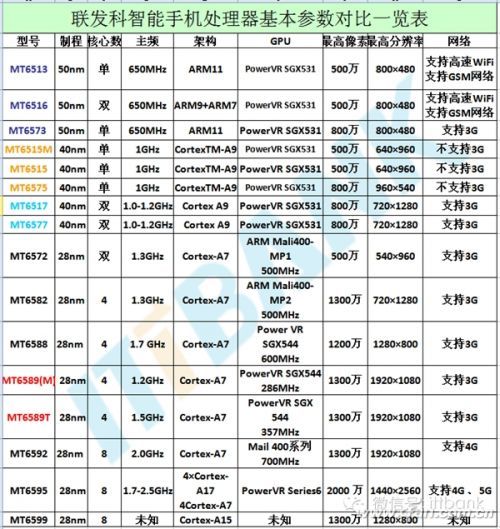MediaTek (MTK) products from Taiwan, China, are widely used by mobile companies and phone design firms in mainland China due to their integration of multiple multimedia features and lower prices. Furthermore, MTK’s completion rate is relatively high, generally above 60%, meaning that mobile manufacturers essentially receive a semi-finished product. With just a little processing, they can quickly launch and ship the devices. This is the primary reason many “black phones” use MTK processors. Below, we will review the main control chips of MTK smartphones:
MT6573/MT6513 Differences: The MT6573 is designed for GSM+WCDMA networks, supporting dual SIM dual standby, while the MT6513 is designed solely for GSM networks and does not support 3G.
MT6515 pertains to solutions for TD smartphones. It supports the Android 4.0 Ice Cream Sandwich operating system, with significant optimizations for multimedia and internet speed. It provides a complete 3G software package for China Mobile, facilitating quicker market entry for mobile manufacturers.
MT6575 is a single-core processor based on the Cortex-A9 architecture, launched in 2012, supporting dual-mode GSM/WCDMA networks.
MT6515M is a cut-down version of the 6575, with a 1GHz ARM CortexTM-A9 processor, supporting only single-mode GSM networks.
The differences between MT6575/MT6515/MT6515M processors: MT6515 has no hardware specification differences from MT6575, except that MT6575 supports Unicom’s WCDMA network, while MT6515 is the TD-SCDMA mobile 3G network version of MT6575. MT6515M is a slightly inferior version overall, supporting only single-mode GSM networks, targeting the entry-level market. The main frequencies of MTK MT6575, MT6515, and MT6515M are all 1GHz, with MT6575 supporting dual-mode GSM/WCDMA networks, MT6515 supporting GSM/TD-SCDMA networks, and MT6515M supporting only GSM networks.
MT6517 GPU is the overclocked version of PowerVR SGX531, supporting the Android 4.0 Ice Cream Sandwich operating system. It supports recording and playback of 1080p/30fps videos. It does not support 3G networks, but some claim it can add support for TD-SCDMA and CDMA basebands, thus enabling TD and telecom 3G networks.
MT6577 supports the Android 4.0 Ice Cream Sandwich operating system. It supports recording and playback of 1080p/30fps videos. It integrates 3G mobile broadband connectivity, supports single-mode HSPA+ networks, and supports GSM, GPRS, and EDGE. It features standalone GPS and assisted GPS modes, and supports Wi-Fi and Bluetooth connectivity. It supports dual SIM dual standby (WCDMA+GSM).
Differences between MT6577/MT6517 processors: MT6517 and MT6577 share the same core, with identical CPU and GPU, hence similar processing capabilities. The former only supports GSM networks and can be paired with the AST3000 to develop mobile TD phones, while the latter directly supports WCDMA networks and can be developed into Unicom 3G phones.
MT6572 is from 2013, supporting HD 720p low-power audio and video playback and recording, a 5-megapixel camera, and HD LCD display (qHD 960X540). It provides digital television (DTV) level image processing and supports multiple network standards including WCDMA, TD-SCDMA, and EDGE. The main chips include: MT6572TD supporting TDSCDMA network standards and MT6572E supporting EDGE networks. The MT6572 series chips have a competitive advantage over the dual-core MT6577 and MT6517 at the same time. It claims to be the world’s first entry-level dual-core smartphone SoC using advanced 28nm process technology, boasting low-power memory and a better CPU architecture for improved energy efficiency and stable performance.
MT6582 has main configuration parameters similar to MT6589, also being a quad-core processor. It supports 1080p 30fps video encoding and decoding and comes with a TD baseband.
MT6588 supports video recording up to 1080P and will support various network standards. The baseband integrates WCDMA and TD multi-mode modem, thus supporting both mobile and Unicom 3G networks.
MT6589M is also a quad-core CPU, but it is a lower-spec version of MT6589. While MT6589 supports Full HD, MT6589M only supports HD, but it can also support WCDMA, TD-SCDMA, and EDGE multi-mode networks. This chip is relatively cost-effective due to lower chip generation costs.
MT6589T has similar parameters to MT6589, but the frequency has been increased from 1.2GHz of MT6589 to 1.5GHz, with the built-in PowerVR SGX 544MP graphics processor frequency also increased to 357M. It can be said to be the high-spec version of MT6589. It is reported that a certain company’s upcoming Redmi phone, which has gained popularity in online sales over the past two years, will use this chip.
MT6589 is a quad-core smartphone chip released in December 2012, claiming to be the world’s first mobile chip integrating W+G/TD+G/W+TD dual communication functions.
MT6592 is a true octa-core CPU chip based on the ARM Cortex-A7 architecture, using a 28nm HPM process, and is manufactured by Taiwan’s TSMC, paired with Mali-450MP GPU, with a maximum frequency of 700MHz.
MT6595 consists of four Cortex-A17 cores and four Cortex-A7 cores, forming a big.LITTLE architecture. It also integrates a new baseband product, supporting LTE Release 9 Cat.4, with maximum upload and download rates of 50Mbps and 150Mbps respectively; it supports dual-mode 4G TD-LTE, FDD-LTE, and also supports DC-HSPA+ 42Mbps, TD-SCDMA, EDGE/GSM.
